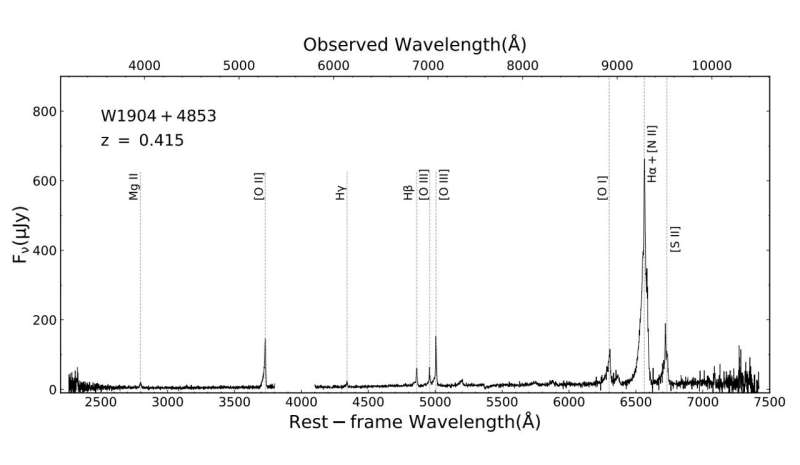June 1, 2023 report
This article has been reviewed according to Science X's editorial process and policies. Editors have highlighted the following attributes while ensuring the content's credibility:
fact-checked
preprint
trusted source
proofread
New hot DOG in the sky: Astronomers discover a hot-dust-obscured galaxy

An international team of astronomers reports the detection of a new, hot-dust-obscured galaxy (DOG). The galaxy, which received designation WISE J190445.04+485308.9, was found at a relatively low redshift of 0.415, which makes it the first confirmed low-redshift hot DOG. The discovery was presented in a paper published May 23 on the arXiv preprint server.
Quasars are galaxies with extremely energetic active galactic nuclei (AGNs). Hot DOGs are a rare type of hyper-luminous obscured quasars identified with Wide-field Infrared Survey Explorer (WISE), specifically classified for being detected via their dust emission. Compared to typical dust-obscured galaxies, hot DOGs are significantly redder in WISE passbands due to their hotter dust emission heated by the AGN and have much higher bolometric luminosities.
Recently, a group of astronomers led by Guodong Li of University of Chinese Academy of Sciences in Beijing, China, has detected another quasar of this rare type. By analyzing the data from WISE and various ground-based telescopes, they found a new hyper-luminous, highly-obscured AGN and designated it WISE J190445.04+485308.9 (or W1904+4853 for short).
"Its well-sampled spectral energy distribution (SED) is dominated by infrared dust emission, though broad emission lines are detected in the optical spectra. These features suggest that W1904+4853 contains an actively accreting supermassive black hole hidden in its dusty cocoon, resembling the observed properties of hot Dust-Obscured Galaxies (hot DOGs), a population previously only identified at z > 1.0," the researchers explained.
According to the study, W1904+4853 has a stellar mass of about 30 billion solar masses and its bolometric luminosity is 11 trillion solar luminosities. The supermassive black hole (SMBH) of W1904+4853 is assumed to be accreting at close to the Eddington limit.
The astronomers found that the Infrared dust emission contributes to approximately 99% of the bolometric luminosity of W1904+4853, dominating the total energy output of this galaxy. The total dust mass was calculated to be some 50 million solar masses, while the dust temperature was estimated to reach 539 K. The researchers assume that in the case of W1904+4853, the dust close to the AGN is heated by the accreting SMBH to higher temperatures than of other infrared-luminous galaxies.
By analyzing the spectral energy distribution (SED) of W1904+4853, the authors of the study found that the galaxy is surprisingly dominated by the young stellar population, with a star formation rate at a level of 45 solar masses per year. This star formation appears to contribute to only 8%t of the far-infrared luminosity, further supporting the scenario in which the infrared dust emission is powered by the AGN.
The research also found ionized gas outflows from the central obscured AGN of W1904+4853. It turned out that the outflow mass is an order of magnitude less than the ongoing star formation rate of the host galaxy, which, according to the researchers, suggests that the outflow power has not been fully launched yet to drive the star-forming material out of the system.
"Although blueshifted and asymmetric [O III] emission provides evidence of an outflow, we estimate it to be an order of magnitude smaller than the star formation rate, indicating that the current obscured AGN activity at the center has not yet produced significant feedback on the host galaxy star formation activity," the astronomers concluded.
More information: Guodong Li et al, Discovery of a Low-Redshift Hot Dust-Obscured Galaxy, arXiv (2023). DOI: 10.48550/arxiv.2305.13739
Journal information: arXiv
© 2023 Science X Network





















